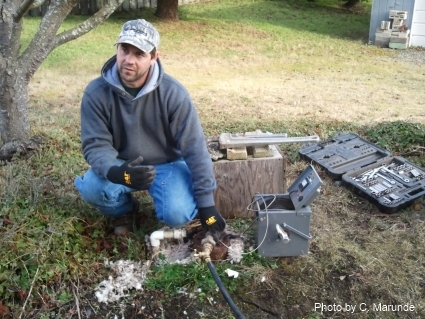Sequim wells are either public or private. If you buy a home or a lot that is not on a public water system, you will have a private well, and there are some critically important issues you definitely want to be aware of when you make an offer. Resolve these issues prior to closing with the right contingencies and the right language. I will share what those critical issues are here, and offer some practical suggestions.
Sequim Wells and Well Inspections
In this photograph Tom Long of TNT Pumps is doing a water flow test on a well. Sequim wells generally produce very good clean water, but there are a few areas where a private well either does not get enough water or the quality of the water requires a filtration system. Here Tom ran the water directly out of the top of the well head through a water hose for one hour, and during this time he used a device (the little gray box shown in this photo) to measure the drop in the water level. From this data he was able to determine how many gallons per minute the well produces. This well produced 10 gallons per minute, which is more than enough water for any family. If the water flow is low, such a 2 or 3 gallons per minute, a well cistern can be installed to store 1,000 gallons, which will then keep up with a normal family’s use. Many Sequim wells produce 15 to 20 gallons per minute, and a few produce over 30. This particular well pump failed in the first few minutes of the test and then worked for the remainder of the hour. The buyers are asking the seller to either replace the pump or credit them the cost of installing a new one, which is about $3,000.
Sequim Wells and Quality
Sequim wells produce high quality water as a general rule, but some buyers will decide to pay a company like TNT Pumps to collect a water sample and send it to a Seattle lab for a bacteria and nitrate test. In the well shown above, the water quality test failed, meaning it had higher levels of bacteria than it should. There is a unique reason that this well failed the water quality test. This home was listed for sale for almost three years, and the home was vacant that entire time. That’s a long time for a home to sit vacant with very little use of the water system. A landscaping company ran the outdoor water sprinklers for a few months during the hottest time of the summer, but that still did not run the pump or use much water over a three year period. The result was well water that was too high in bacteria.
What did this mean? It just meant the well and the water lines had to be chlorinated, which typically will cost about $250. Not the end of the world, but still important to take care of if your buying a home with a private well.
Sequim wells do not have major problems as a rule, but a particular well could if it has not been used much or if it is in an area with water problems. I recommend being very careful to use the right contingency language and the right timelines when you draft your offer to be sure you don’t get stuck with a serious problem. It’s wise to understand Sequim wells and the issues of Sequim wells when you are buying.
Last Updated on December 8, 2010 by Chuck Marunde


































Have you any experience about sand getting into the well water pump. I live at 12 Big Foot Lane and had to replace the pump twice in the past year because of sand in the well. Thanks
Chuck Marunde: Yes, I’ve seen that during well inspections. I talked with Canal Pumps in Sequim about the cause, and they recommend you bring a sample of the sand into their office, and they can identify it for you right away. What many people think is sand is actually rust particles. If it is rust, they can trouble shoot the source or the cause. I recommend taking a sample to them. Their office is in Carlsorg at 110 Village Ln, and their phone number is (360) 683-6328.